2. 日本产业技术综合研究所, 筑波 305-8567
2. National Institute of Advanced Industrial Science and Technology(AIST), Tsukuba, 305-8567 Ibaraki-ken, Japan
The experiments were performed in a high pressure vessel of a loading system. First, the confining pressure was increased slowly to 10 MPa, which is equal to the stress conditions existing at depth ~1 km in the subsurface. Second, when the confining pressure was kept constant, the axial stress was increased at a constant rate of 2 MPa/min until the specimen fractured. The AE events were monitored by a high-speed multi-channel waveform recording system. In addition, the ultrasonic transmission measurement was periodically applied to monitor the P velocity and amplitude change induced by the confining pressure and axial stress during the process of loading. Finally, a 3D X-ray CT scanning was carried out for the broken specimen to reconstruct the fault geometry and the heterogeneous structure. The combination of strain-stress data and associated AE is used to discuss the mechanical performance of the specimens.
The experimental results can be summarized as follows: (1) The P velocities of both dolomite and shale increase in the initial loading stage. When the axial loading exceeds 30 MPa, the P velocities of two samples keep constant. It indicates that there is little micro-crack in both two samples. (2) Both dolomite and shale demonstrate brittle behavior. (3) The strength of dolomite is 324 MPa. The sample is compressed in the axial direction and dilated in the circumferential direction under the initial axial loading. However, when the axial stress reaches 280 MPa, the volumetric strain is dominated by the circumferential strain, contributing to the increase of the sample volume, which is known as rock dilatancy. (4) During the experiment of dolomite, there are two significant stress drops. The main fracture forms as soon as the second stress drop occurs. According to the location of AE hypocenters, there are two fracture planes which are located in the lower part of the sample. In addition, there are a lot of foreshocks prior to the first stress drop. (5) The strength of shale is 197 MPa. During the entire loading stage, the axial strain plays a dominant role in the volumetric strain, leading to the decrease of the sample volume. (6) During the experiment of shale, there are several stress drops. The foreshocks of shale are relative lower than those of dolomite. The location of AE hypocenters is along the foliation, indicating the dominate role of foliation on the mechanical performance of shale. (7) A great amount of AE events happen during the dynamic fracturing and aftershocks take place in both rock samples. (8) The foliation orientation with respect to the direction of the principal stress is 15°, which is considered to be the most favorable angle. Such oriented foliation plays a key role in determining the peak strength, the precursory behavior preceding the final fracture, the spatiotemporal distribution of AE events and the geometry of the faulting plane. (9) The comparison between the AE distribution and X-ray CT scan images shows an excellent agreement between the location of AE hypocenters and the position of the macroscopic shear band and the final narrow fault.
This paper describes the rock fracture tests of dolomite and shale from the Sichuan Basin, China under a triaxial compression. The experimental results indicate that the brittle failure behavior of both dolomite and shale is the key factor for understanding the extremely high level of UFI induced seismicity and hydraulic fracturing for shale gas exploitation. The activities of seismicity themselves have a positive effect on monitoring of the initiation and growth of cracks. In addition, the formation of the fractures can enhance the oil/gas recovery and improve the sequestration potential of carbon dioxide. At the same time, an advanced injection management plan is very required for the aforementioned geoengineering to avoid damaging events.
近年,随着二氧化碳地质封存、深部地热开采、地下储气库建设、页岩气开发、二次驱油/驱气等工业应用的快速发展,与地下流体注入有关的诱发地震活动呈现一定的增加趋势,引起学术界及公众 的广泛关注(刁守中,1989; Sminchak and Gupta, 2003; Majer et al., 2007; Lei et al., 2008,2013a; 阮祥等,2008; Verdon et al., 2010).如何利用微震活动进行注水管理及如何评估规模较大且具有破坏性的诱发地震的发生条件,并进而开发相应的预测、预防技术,已成为迫切的研究课题.油气田注水诱发的规模较大地震主要由孔隙压增加、已有断层剪切强度下降而导致断层重新活动而产生,与注水压力、储层及圈闭层岩性、裂隙及断层分布情况、构造应力环境等多种因素有关(Lei et al., 2008,2013a; 许华明等,2008).研究不同尺度下这些因素的作用是把握实际现场注水诱发地震发生条件从而开发监测预防技术的基础之一.其中,在实验室尺度下,研究油气田典型岩石在压缩变形和注水条件下的破坏特征是这一领域的重要研究方向之一(Lei et al., 2011; Perera et al., 2011; 李庆辉等,2012; Shukla et al., 2012; 杨建等,2012).声发射是(脆性)岩石在受力变形过程中的微破裂活动所产生的弹性波辐射,因此声发射方法是揭示脆性岩石变形破坏过程的有效工具(Lockner,1993; Lei et al., 2000a; 裴建良等,2013).由于岩石破裂与地震活动之间的相似性,岩石破裂声发射研究在地震机理研究中得到广泛应用(刘力强等,1999; Lei et al., 2004; 马胜利等,2004).
与四川盆地天然气田及井盐有关的注水诱发地震活动十分典型(Lei et al., 2008; 阮祥等,2008).为了了解四川盆地地层岩石的力学特性,我们开始了利用室内声发射技术对现场采集的岩石标本进行岩石三轴条件下变形破坏过程中地震波速度等物性及声发射事件空间分布的变化特征的系列研究.由于四川盆地的典型储层包括白云岩、灰岩,而页岩作为非常规储层近年来备受关注.作为初步研究成果,本文主要研究震旦系白云岩及页岩,在压缩破坏过 程中,声发射事件的时空分布特征及其与岩石压缩变形破坏的关联特征,并讨论其在页岩气压裂开采及二氧化碳地质封存诱发地震理论方面的意义. 2 岩石样本与实验方法
实验的样本是采自四川盆地北部旺苍县正源乡东河谷边的震旦系白云岩及页岩.样本采集点系建筑新挖出来的新鲜露头.四川盆地是在扬子克拉通基底之上发育的叠合盆地,上震旦统到中三叠统为海相沉积,以碳酸盐岩为主(刘树根等,2008; 魏国齐等,2013).储层岩石类型包括白云岩、鲕粒灰岩、礁灰岩等,储集空间以裂缝-孔隙型为主,孔隙度一般为2%~5%(杜金虎,2010).其中,上震旦统与寒武系碳酸盐岩基本上完全白云石化,其余层位也具有不同程度白云石化(刘树根等,2008).页岩为四川盆地烃源岩的重要组成部分,不仅生气强度高,而且分布面积大,是盆地天然气资源的主要贡献者(张金川等,2008).因此,采集的白云岩及页岩分别作为储集层或页岩气储集层,具有一定的代表性.根据岩石力学实验要求,标本的长短轴比为2.5 ∶ 1,我们将岩石样本加工成直径50 mm,长125 mm的圆 柱体(见图 1).白云岩宏观上较均匀,而页岩具有明显的层理面,其方向与轴向方向呈15°左右.研究表明层理等面状结构对岩石变形破坏过程具有控制作用(Lei et al., 2013b).因此页岩层理可能影响破坏过程并控制最终破坏面的形态.实验时,直接在样本表面布设24个直径为5 mm、共振频率为2 MHz的压电陶瓷传感器(PZT)(图 2).PZT不仅作为声 发射信号的接收探头,同时也作为发射探头用来测 量岩石变形过程中的P波速度.实验中可通过快速自动开关系统实现接收与发射的切换.另外,6组十字形应变片安装在测试样本表面的中心位置,用以测量变形过程中岩石的轴向(Sa)及径向(Sc)应变,据此计算体积应变:Sv=Sa+2Sc.最后,在样本表面涂抹5~6 mm厚的硅胶用来防止液压油渗透到岩石标本中.实验在三轴容器中进行,采用等应力速率加载方式.
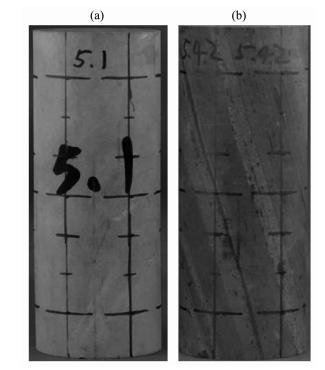 | 图 1 实验用岩石样本(a为白云岩,b为页岩,采自四川旺苍县正源乡) Fig.1 Rock samples for experiment(a: dolomite, b: shale,both from the Sichuan Basin) |
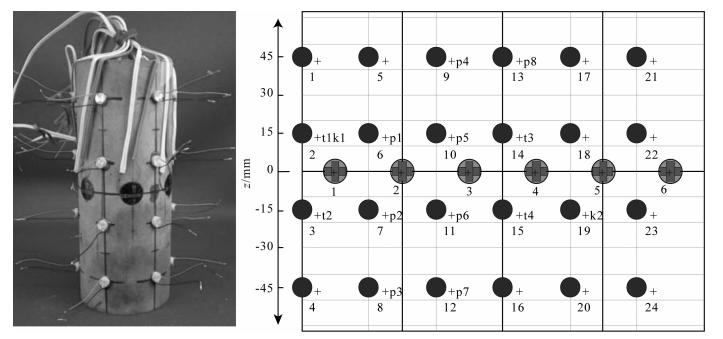 | 图 2 岩石表面探头及应变片排列方式 p1—p8表示该探头能够转换工作模式作为信号发生源;k1、k2表示该探头还用来记录声发射的 峰值振幅和计数;t1、t2、t3、t4表示该探头作为声发射波形记录的触发探头. Fig. 2 The arrangement of PZTs and strain gauges p1—p8 represent the PZTs can switch the mode between receiver and source. k1,k2 represent the PZTs can be used for recording the number and amplitude of AE events. t1、t2、t3、t4 represent the PZTs can be used for trigger. |
本次实验在日本产业技术综合研究所的三轴压缩装置及多通道声发射波形采集系统下进行(图 3)(Lei et al., 2000b; Lei,2006; Li et al., 2007).该系统主要包括加载系统、声发射记数及波形采集系统、应力-应变监测系统三部分.加载系统包含轴压加载及围压加载,压力容器放置在2000 t单轴压缩实验机内,液压油通过管线进入到压力容器中对岩样施加围压.声发射波形采集系统由放大器及两套12通道最高采样速率为100 MHz、分辨率为16 bit的全波形高速模数转换卡组成.探头接收到的信号经过40 dB的放大器后传递给声发射波形采集卡.采集卡的死时间小于200 μs,因此可以记录几乎所有可探测AE信号的全波形数据.特别是在破坏瞬间,AE速率高达每秒几千个时,也能较全面地记录绝大多数AE事件,对岩石的破坏过程进行详细研究.除波形记录外,位于样本中部的两个PZT信号 k1、k2经过20 dB的放大器放大后接到峰值探测器记录声发射数及峰值振幅.多通道快速开关系统(switch box)能够使得多个探头(图 2中p1—p8探头)在AE接收器和发射源之间切换.轴压、围压、轴向及径向应变通过分辨率为16 bit的应力-应变监测系统记录.实验结束后对破坏样本进行X射线CT断层扫描,分析岩石内部破裂面形态,并与声发射结果进行比对.
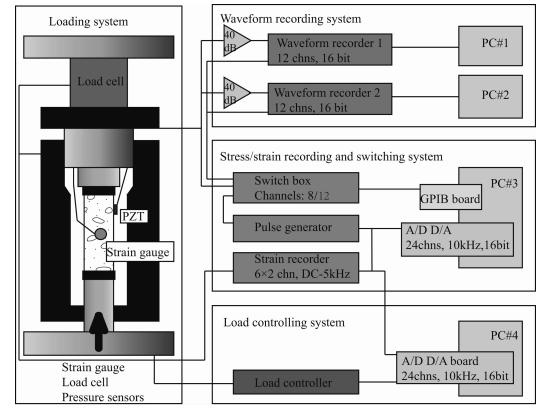 | 图 3 试验装置系统框图 Fig. 3 Block diagram of the experiment apparatus |
两个实验中围压均为10 MPa,相当于地下近1 km左右深度处的静水压力大小.轴向应力以2~5 MPa/min的速率加载至标本破裂.按照一定的时间间隔,依次转换p1—p8探头的工作模式测量在不同应力下岩石的波速.声发射采集系统记录24通道声发射的全波形数据,AE震源定位根据P波的初始到达时间确定(Lei et al., 2000a). 3 实验结果
白云岩及页岩纵波速度随轴向应力的变化图,如图 4所示.在应力加载初期阶段,随着轴向应力的增加,白云岩的波速有一定增加,页岩的波速有所增加但幅度不明显.当轴向应力大于30 MPa时,两种岩石的P波速度基本上保持不变.这个现象说明两种岩石均比较致密,内部微裂隙总体较少,白云岩的预存裂隙比页岩相对多些.
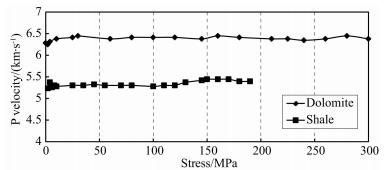 | 图 4 纵波速度随轴向应力的变化关系图 Fig. 4 P velocity along horizontal direction against axial stress |
白云岩的实验结果可以归纳为以下几点:
(1)根据应力-应变曲线,在围压为10 MPa的情况下,对岩石进行等应力速率加载,最终发生脆性破坏,其破坏强度为324 MPa(图 5).在轴向加压过程中,白云岩岩芯样本轴向被压缩,径向发生膨胀变形.在初期阶段其体积应变由轴向压缩控制,岩石总体积减小,但当应力增加到280 MPa左右时,其体积应变由径向膨胀控制,岩石总体积变大,说明有一定的扩容现象.
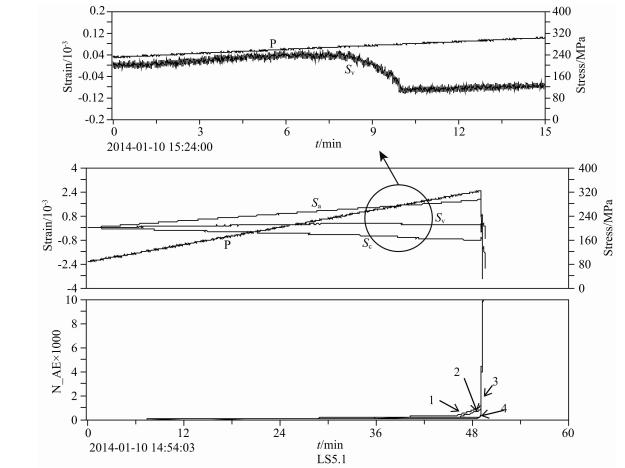 | 图 5 白云岩应力-应变结果及声发射时间序列图 Sa为平均轴向应变,Sc为平均径向应变,Sv为体积应变(Sv=Sa+2Sc). P代表轴向应力; 1,2代表k1、k2探头记录的声发射累计数;3代表两台声发射采集卡记录波形的数量;4代表有效声发射定位点的数量. Fig. 5 Plots of stress,strain and AE number as functions of time for dolomite Sa is the mean axial strain,Sc is the mean circumferential strain,Sv is the volumetric strain(Sv=Sa+2Sc). The P for axial stress; The line 1 and line 2,for the AE numbers recorded by two peak detectors connected with sensor k1 and k2; The line 3 for the number of waveforms; The line 4 for the number of well-located events. |
(2)实验中声发射累计数可通过两种方式得到:k1、k2(图 2)探头的声发射计数;声发射波形采集卡记录的事件数.后者的触发门槛高于前者近两倍,因此前者计数要(远)大于后者.如图 6所示,实验过程中有两次明显的应力降,第一次应力降之前的4 s时间内,声发射开始大量产生,主要集中在岩石下端部分,微裂缝开始产生,形成第一条裂纹(图 7).但由于岩石未整体破裂,左半部分仍然承受一部分应力,因此应力的变化趋势不是突然降低,而是缓慢减小.在接下的2 s内,微裂纹向右边延伸,声发射集中在岩石的下半部分.第二次应力降发生较突然,岩石发生脆性断裂,岩石右边主断裂形成.由于实验操作问题,实验最后阶段未能记录到波形数据,但是根据k1、k2探头记录的声发射数,说明这一阶段还有大量声发射产生,根据破坏后岩石CT断层扫描结果,推测这一阶段的声发射集中在右边破裂面处.整个破裂阶段只持续10 s,快速应力降产生之前,峰值应力前后就已有大量声发射活动加速产生的过程,理论上可以根据声发射活动预测最终破裂发生的时间(Lei,2006).
 | 图 6 白云岩样品最后破坏阶段声发射时空分布图及破坏样品的X-射线CT扫描结果 P代表轴向应力;1、2代表k1、k2探头记录的声发射累计数;3代表两台声发射采集卡记录波形的数量;4代表有效声发射定位点的数量. Fig. 6 The spatio-temporal distribution of AE hypocenters and a cross-section of the CT scan images of the dolomite sample The P for axial stress; The line 1 and line 2,for the AE events recorded by two peak detectors connected with sensor k1 and k2; The line 3 for the number of waveforms; The line 4 for the number of well-located events. |
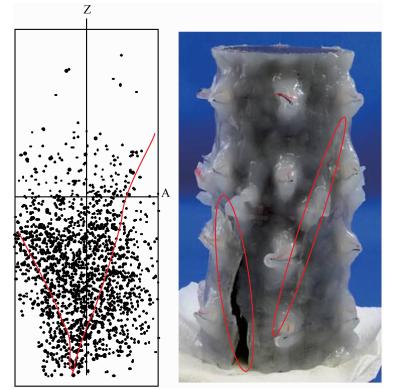 | 图 7 白云岩声发射分布及宏观断层位置 Fig. 7 The location of AEs and the broken dolomite sample |
(3)从破坏后的岩石标本及声发射定位结果可知,该岩石有两条断裂面,发生在岩石的下端部分,声发射定位结果丛集在断裂面附近.
图 8—10为页岩的结果,有以下几点主要认识:
(1)根据应力-应变曲线,在围压为10 MPa的情况下,对页岩进行等应力速率加载,最终发生脆性破坏,其破坏强度为197 MPa.在整个破坏过程中,体积应变主要由轴向应变控制,岩石发生压缩,总体积一直在变小,没有明显的扩容现象.
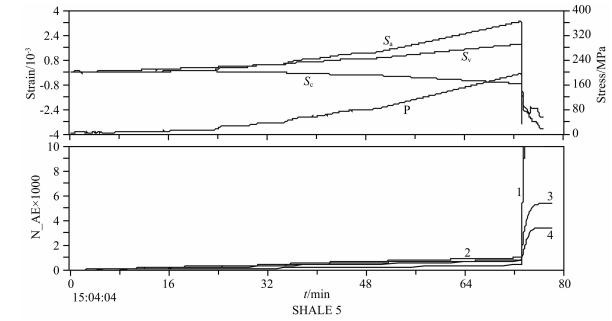 | 图 8 页岩应力-应变结果及声发射时间序列图 P代表轴向应力;1、2代表k1、k2探头记录的声发射累计数;3代表两台声发射采集卡记录波形的数量; 4代表有效声发射定位点的数量. Fig. 8 Plots of stress,strain and AE number as functions of time for the shale sample The P for axial stress; The line 1 and line 2,for the AE events recorded by two peak detectors connected with sensor k1 and k2; The line 3 for the number of waveforms; The line 4 for the number of well-located events. |
(2)根据页岩的应力随时间的变化曲线(图 9),页岩在破坏过程中发生了多次大小不等的快速应力降.与白云岩不同的是,在第一次主要应力降发生之前,页岩的声发射数较少,主要集中在上下两个层理面附近.根据声发射定位结果,第一次主要应力降发生前后,声发射主要集中在上下多条层理面附近,沿层理面方向具有线(面)状丛集现象,说明该阶段主要是由于层理面发生错动,多个破裂面沿着层理面产生.第二阶段应力保持在154 MPa左右,时间持续10 s,声发射大量增加,其位置集中在几个层理面附近,并有大量声发射连接不同层理面,说明在这个阶段内岩石沿着已经形成的断层面及层理面发生错动,裂纹从靠近端部处开始萌生,接着相邻两层理面的裂纹开始延伸,最后相互贯通形成的主破裂面导致岩石破坏.第二次主要应力降产生后,声发射活动速率变慢,并且分布在样品内部整个空间,但沿层理面方向仍具有线(面)状丛集现象.明显的声发射活动持续40 s以上,较白云岩长.
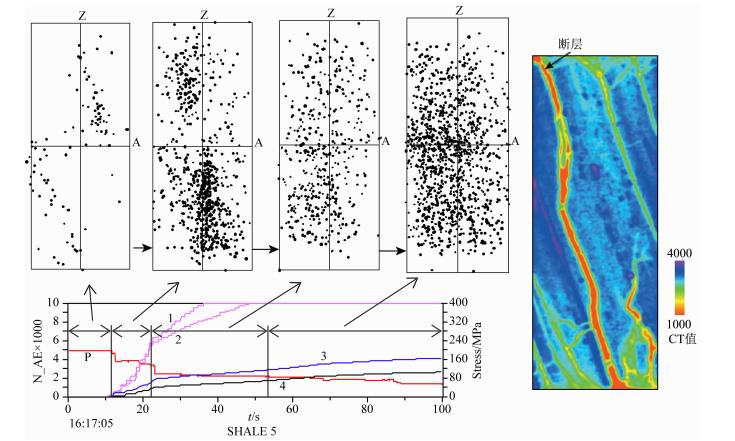 | 图 9 页岩样品最后破坏阶段声发射时空分布图及破坏样品的X-射线CT扫描结果 P代表轴向应力;1,2代表k1、k2探头记录的声发射累计数;3代表两台声发射采集卡记录波形的数量;4代表有效声发射定位点的数量. Fig. 9 The spatio-temporal distribution of AE hypocenters and a cross-section of the CT scan images of the shale sample The P for axial stress; The line 1 and line 2,for the AE events recorded by two peak detectors connected with sensor k1 and k2; The line 3 for the number of waveforms; The line 4 for the number of well-located events. |
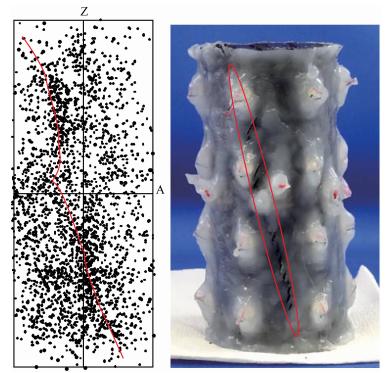 | 图 10 页岩声发射分布图及宏观断层位置 Fig. 10 The location of AEs and the broken shale sample |
(1)声发射技术在岩土工程领域已经被广泛应用.众多国内外学者开展了大量的基础实验进行声发射理论研究,并得到了岩石类材料声发射特征的 一般规律:连续加载时,根据声发射特征可将岩石破坏变形过程分为几个典型的阶段:初期阶段(primary)、第二阶段(secondary)、成核阶段(nucleation)、 动态破坏(dynamic fracturing)及余震(after-shocks)(Lei et al., 2000b,2004; Lei,2006).动态破坏前各阶段受岩石非均匀性尤其是预存微裂纹的密度和尺寸控制而具有十分不同的表现.如前所述,本研究所用的两种岩石均比较致密,内部微裂隙总体较少,因此动态破坏前各阶段声发射活动不明显,只有一个比较短暂的成核阶段.大量声发射发生在动态破坏及余震阶段.其中,成核阶段对应于岩石宏观破裂面的出现,裂纹非稳定性扩展.对于页岩,由于层理面为岩石的结构弱面,其方向与最大主应力轴之间的角度为15°,有利于沿其发生剪切破坏,发生多次动态破坏并形成多个破裂面.大量声发射活动对应于断层形成后的摩擦滑动及余震.参考以往多方向具有较强层理结构的岩芯破坏实验结果,有必要指出该类岩石的变形破坏过程受层理面或页理面与最大主应力轴之间的角度控制,当结构面较大或较小时,其破坏过程会更复杂(Lei et al., 2013b).
(2)岩石的非均匀性控制着岩石变形破坏过程,影响声发射的空间分布(Lei et al., 2000a; 马胜利等,2004).由于页岩存在宏观层理面,且其最终破坏面沿着其宏观层理面.声发射空间定位结果也证实页岩的微裂缝在层理面处开始生成,随着应力的增加,微裂缝沿着层理面扩展,最后由于上下两处微裂缝相互贯通而导致最终破裂.白云岩由于其无明显的宏观非均匀性,并且根据声发射时间序列图可以观察到在应力加载初期阶段声发射已经开始产生,岩石内部微裂缝开始萌生.在应力作用下由于裂纹的扩展产生声发射,最终破裂面的形态与微裂纹的扩展尤其关键部位的微裂纹扩展有关.比较两种岩石的变形破坏过程及声发射的时空分布特征,本文的实验证实了白云岩与页岩的破坏机制的差异.对于层理面十分发育的岩石,层理是控制破裂过程及声发射空间分布的决定性因素.据此可以推断,在大尺度下,白云岩的层理也将成为控制储层变形破坏的重要因素.
(3)微震活动时空分布特征是地震预报的重要依据.宏观构造(节理、层面)等非均匀性的存在使得主破裂的时间和空间预报成为可能(刘力强等,1999; Lei et al., 2004; 马胜利等,2004).根据白云岩及页岩的声发射时空分布图,白云岩由于其较均匀,没有明显的宏观构造,预存裂隙也较少,明显的声发射活动几乎在峰值应力附近开始,因此从声发射开始产生至岩石动态破坏的过程很短(只持续了4 s).页岩由于存在明显的层理面,主破裂为上下两层理面之间的裂纹相互连通形成的断裂面,其动态破坏之前具有相对较长的声发射加速过程.
(4)如前所述,白云岩为四川盆地的典型储层岩石,而页岩是主要圈闭岩层同时又为四川盆地烃源岩的重要组成部分,是盆地天然气资源的主要贡献者.因此,研究这两种岩石的力学特性对于四川盆地油气开采或页岩气开发具有重要的指导意义.根据本文的实验结果,不管是白云岩还是页岩,在地下几公里范围以内的条件下均表现为脆性破坏特征.本研究的有效围压只相当于地下1 km深度,但后续实验研究表明本文结论可以外延到2~3 km以上,从而涵盖四川盆地主要诱发地震活动所对应的深度范围,有关结果将在后续论文发表.脆性破坏是诱发地震产生的必要因素.因此,当对白云岩储层进行油气开采或二氧化碳地质封存时,容易引起微震活动.但微裂缝的形成能够增加储层的渗透性,提高油气产量及二氧化碳的封存潜力.当进行页岩气开采时,页岩的力学特性有利于在页岩储层中进行水力压裂,且页岩储层一般具有宏观节理面,节理面的存在使得控制水力压裂破坏面的延伸方向成为可能,有助于最大限度地进行页岩气开采.鉴于四川盆地已发生多次震级4以上具有一定灾害性的中强诱发地震,有必要在页岩气开发及二氧化碳地质封存时采 取相应的预防控制措施进行安全合理的储盖层管理,避免灾害性诱发地震的发生,为此,开展微震观测研究将十分必要. 5 结论
通过对四川盆地现场采集的白云岩及页岩在室内三轴条件下的声发射实验,观测岩石变形破坏过程中地震波速度等物性及声发射事件时空分布特征,得出以下主要结论:
(1)白云岩及页岩在压缩过程中主要由轴向压缩控制,白云岩在压缩的后期阶段出现了一定的扩容现象,但页岩在整个压缩阶段没有明显的扩容现象.两种岩石最终破坏均为脆性破坏.因此推断,在地壳浅部的白云岩储层中进行油气开采或者二氧化碳地质封存时容易引起诱发地震,但同时能够提高油气产量及二氧化碳的封存潜力.在页岩气储层中进行水力压裂开采时容易形成裂缝,有助于页岩气开采.
(2)层理面是控制页岩主断裂形态及声发射空间分布的决定性因素.在储层尺度下,所有沉积岩的层理及构造及其相对于区域构造应力场主应力的方向都将成为控制储层变形破坏的重要因素.
(3)声发射定位结果主要集中在断裂面附近,因 此能够较准确地反映岩石的破坏面,同时根据声发 射时空特征,能够有效揭示岩石变形破坏的全过程.该实验结果对指导四川盆地二氧化碳地质封存及页岩气压裂开采提供一定的科学依据.
致谢 感谢费文斌和井淼在野外考察取样过程中给予的帮助.感谢两位审稿人详细认真的审稿意见,使本文得以提高和完善.| [1] | Diao S Z. 1989. Time distribution feature of seismic sequence induced by water flooding in Jiao 07 well in Shandong province. Earthquake (in Chinese), (1): 27-31. |
| [2] | Du J H. 2010. Natural Gas Exploration of Permian-Triassic Reef & Oolite in Sichuan Basin (in Chinese). Beijing: Petroleum Industry Press. |
| [3] | Lei X L. 2006. Typical phases of pre-failure damage in granitic rocks under differential compression. Geological Society, London, Special Publications, 261(1): 11-29, doi: 10.1144/gsl.sp.2006.261.01.02. |
| [4] | Lei X L, Kusunose K, Nishizawa O, et al. 2000a. On the spatio-temporal distribution of acoustic emissions in two granitic rocks under triaxial compression: The role of pre-existing cracks. Geophysical Research Letters, 27(13): 1997-2000, doi: 10.1029/1999gl011190 |
| [5] | Lei X L, Kusunose K, Rao M V M S, et al. 2000b. Quasi-static fault growth and cracking in homogeneous brittle rock under triaxial compression using acoustic emission monitoring. Journal of Geophysical Research: Solid Earth, 105(B3): 6127-6139, doi: 10.1029/1999jb900385. |
| [6] | Lei X L, Masuda K, Nishizawa O, et al. 2004. Detailed analysis of acoustic emission activity during catastrophic fracture of faults in rock. Journal of Structural Geology, 26(2): 247-258, doi: 10.1016/s0191-8141(03)00095-6. |
| [7] | Lei X L, Yu G Z, Ma S L, et al. 2008. Earthquakes induced by water injection at -3 km depth within the Rongchang gas field, Chongqing, China. Journal of Geophysical Research: Solid Earth, 113(B10310), doi: 10.1029/2008jb005604. |
| [8] | Lei X L, Tamagawa T, Tezuka K, et al. 2011. Role of drainage conditions in deformation and fracture of porous rocks under triaxial compression in the laboratory. Geophysical Research Letters, 38(L24310), doi: 10.1029/2011gl049888. |
| [9] | Lei X L, Ma S L, Chen W K, et al. 2013a. A detailed view of the injection-induced seismicity in a natural gas reservoir in Zigong, southwestern Sichuan Basin, China. Journal of Geophysical Research: Solid Earth, 118(8): 4296-4311, doi: 10.1002/jgrb. 50310. |
| [10] | Lei X L, Funatsu T, Villaescusa E. 2013b. Fault formation in foliated rock-insights gained from a laboratory study. // Proc 8th Int Symp on Rockbursts and Seismicity in Mines (RaSim8): Moscow, 41-49. |
| [11] | Li Q, Wu Z S, Lei X L, et al. 2007. Experimental and numerical study on the fracture of rocks during injection of CO2-saturated water. Environmental Geology, 51(7): 1157-1164, doi: 10.1007/s00254-006-0406-y. |
| [12] | Li Q H, Chen M, Jin Y, et al. 2012. Rock mechanical properties and brittleness evaluation of shale gas reservoir. Petroleum Drilling Techniques (in Chinese), 40(4): 17-22. |
| [13] | Liu L Q, Ma S L, Ma J, et al. 1999. Spatial and temporal distribution of acoustic emission in different structure granitic rocks under triaxial compression and their significance in seismology. Chinese Science Bulletin (in Chinese), 44(11): 1194-1198. |
| [14] | Liu S G, Huang W M, Zhang C J, et al. 2008. Research status of dolomite genesis and its problems in Sichuan Basin. Lithologic Reservoirs (in Chinese), 20(2): 6-15. |
| [15] | Lockner D. 1993. The role of acoustic emission in the study of rock fracture. International Journal of Rock Mechanics and Mining Sciences & Geomechanics Abstracts, 30(7): 883-899, doi: 10.1016/0148-9062(93)90041-B. |
| [16] | Ma S L, Lei X L, Liu L Q. 2004. Effects of heterogeneity in rock samples on spatial and temporal distribution of acoustic emission and their significance in seismology. Chinese Journal of Geophysics (in Chinese), 47(1): 127-131, doi: 10.3321/j.issn:0001-5733.2004.01.019. |
| [17] | Majer E L, Baria R, Stark M, et al. 2007. Induced seismicity associated with enhanced geothermal systems. Geothermics, 36(3): 185-222, doi: 10.1016/j.geothermics.2007.03.003. |
| [18] | Pei J L, Liu J F, Zuo J P, et al. 2013. Investigation on dynamic evolution process of natural fractures based on acoustic emission position. Chinese Journal of Rock Mechanics and Engineering (in Chinese), 32(4): 696-704. |
| [19] | Perera M S A, Ranjith P G, Peter M. 2011. Effects of saturation medium and pressure on strength parameters of Latrobe Valley brown coal: Carbon dioxide, water and nitrogen saturations. Energy, 36(12): 6941-6947, doi: 10.1016/j.energy.2011.09.026. |
| [20] | Ruan X, Cheng W Z, Zhang Y J, et al. 2008. Research of the earthquakes induced by water injections in salt mines in Changning, Sichuan. Earthquake Research in China (in Chinese), 24(3): 226-234. |
| [21] | Shukla R, Ranjith P G, Choi S K, et al. 2012. A novel testing apparatus for hydromechanical investigation of rocks: Geo-sequestration of carbon dioxide. Rock Mechanics and Rock Engineering, 45(6): 1073-1085, doi: 10.1007/s00603-012-0241-2. |
| [22] | Sminchak J, Gupta N. 2003. Aspects of induced seismic activity and deep-well sequestration of carbon dioxide. Environmental Geosciences, 10(2): 81-89, doi: 10.1306/eg100202009. |
| [23] | Verdon J P, Kendall J M, White D J, et al. 2010. Passive seismic monitoring of carbon dioxide storage at Weyburn. The Leading Edge, 29(2): 200-206, doi: 10.1190/1.3304825. |
| [24] | Wei G Q, Shen P, Yang W, et al. 2013. Formation conditions and exploration prospects of Sinian large gas fields, Sichuan Basin. Petroleum Exploration and Development (in Chinese), 40(2): 129-138. |
| [25] | Xu H M, Qu G S, Li X C, et al. 2008. Analysis of mechanism and influencing factors of earthquake induced by water injection. Northwestern Seismological Journal (in Chinese), 30(3): 221-226. |
| [26] | Yang J, Fu Y Q, Chen H F, et al. 2012. Rock mechanical characteristics of shale reservoirs. Natural Gas Industry (in Chinese), 32(7): 12-14. |
| [27] | Zhang J C, Nie H K, Xu B, et al. 2008. Geological condition of shale gas accumulation in Sichuan Basin. Natural Gas Industry (in Chinese), 28(2): 151-156. |
| [28] | 刁守中. 1989. 山东角07井注水诱发地震序列的时间分布特征. 地震, (1): 27-31. |
| [29] | 杜金虎. 2010. 四川盆地二叠-三叠系礁滩天然气勘探. 北京: 石油工业出版社. |
| [30] | 李庆辉, 陈勉, 金衍等. 2012. 页岩气储层岩石力学特性及脆性评价. 石油钻探技术, 40(4): 17-22. |
| [31] | 刘力强, 马胜利, 马瑾等. 1999. 三轴压缩下不同构造花岗岩的微破裂时空分布特征及其地震学意义. 科学通报, 44(11): 1194-1198. |
| [32] | 刘树根, 黄文明, 张长俊等. 2008. 四川盆地白云岩成因的研究现状及存在问题. 岩性油气藏, 20(2): 6-15. |
| [33] | 马胜利, 雷兴林, 刘力强. 2004. 标本非均匀性对岩石变形声发射时空分布的影响及其地震学意义. 地球物理学报, 47(1): 127-131, doi: 10.3321/j.issn:0001-5733.2004.01.019. |
| [34] | 裴建良, 刘建锋, 左建平等. 2013. 基于声发射定位的自然裂隙动态演化过程研究. 岩石力学与工程学报, 32(4): 696-704. |
| [35] | 阮祥, 程万正, 张永久等. 2008. 四川长宁盐矿井注水诱发地震研究. 中国地震, 24(3): 226-234. |
| [36] | 魏国齐, 沈平, 杨威等. 2013. 四川盆地震旦系大气田形成条件与勘探远景区. 石油勘探与开发, 40(2): 129-138. |
| [37] | 许华明, 曲国胜, 李行船等. 2008. 注水诱发地震的成因及影响因素探讨. 西北地震学报, 30(3): 221-226. |
| [38] | 杨建, 付永强, 陈鸿飞等. 2012. 页岩储层的岩石力学特性. 天然气工业, 32(7): 12-14. |
| [39] | 张金川, 聂海宽, 徐波等. 2008. 四川盆地页岩气成藏地质条件. 天然气工业, 28(2): 151-156. |
 2015, Vol. 58
2015, Vol. 58


